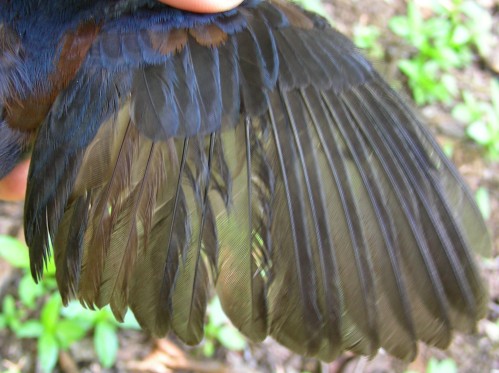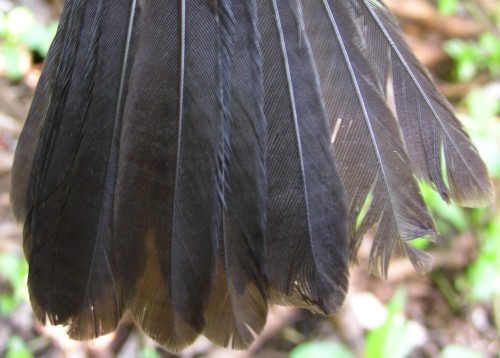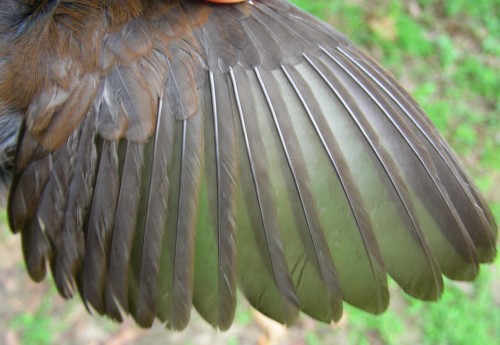|
|
|
Blue-black Grosbeak / Picogrueso Negro Azulado (Cyanocompsa cyanoides) |
QUICK TIPS:
1) Consider overall plumage - birds with at least some glossy blue-black are males, while those that are uniformly brown are females or possibly young males
2) Examine the wing - on males, blue-black feathers may be more extensive on ASY birds
3) Examine the rectrices - on ASY birds they are likely to be relatively broad and round, while on SY birds they are likely to be more narrow and tapered |
Species account updated March 2009
|
Ageing and sexing overview:
|
Spring: |
ASY - M
Body mostly to entirely blue-black, glossy in places; rectrices broad and rounded. |
|
|

|
ASY - F
Body uniformly brown; wing uniform in colour and wear; rectrices broad and rounded. |
|
|
|
SY - M
Body brownish with variable amounts of blue-black; wing largely brownish, possibly with some blue-black; rectrices relatively narrow and tapered. |
|
|
|
SY - F
Body uniformly brown; wing possibly showing moult limits; rectrices relatively narrow and tapered. |
|
|
|
|
Ageing and sexing details:
|
SPRING: ASY-M (after-second-year male) |
Although the individual below is tentatively classified as ASY on the basis of having much more extensive blue-black plumage than the SY-M lower on this page, the flecks of brown on the head (as well as the moult limit in the wing below) suggest this may actually also be a second-year bird, that for some reason is just much more advanced in its moult. Further study is required.

Photo by Marcel Gahbauer, Las Caletas (CR),
April 2008
Most of the primaries and secondaries, and all of the primary coverts and greater coverts appear to be adult feathers, consistent with an ASY Blue-black Grosbeak. However, there are two retained central secondaries that appear to be brown juvenile feathers, and this is also the case for a couple of median coverts and the alula. Collectively, these suggest either that this is a second-year bird with moult much more advanced than the other one further down this page, or that a few juvenile feathers may be retained by third-year Blue-black Grosbeaks.

Photo by Marcel Gahbauer, Las Caletas (CR),
April 2008
The tail below shows mostly broad and rounded rectrices, though it appears that the outer two feathers may be from a previous generation, indicating incomplete moult on the tail as well as the wing.

Photo by Marcel Gahbauer, Las Caletas (CR),
April 2008
RETURN TO AGE/SEX
OVERVIEW
SPRING: ASY-F (after-second-year female) |
Female Blue-black Grosbeaks are uniformly brown; no overall body plumage features are known that would help distinguish SY from ASY birds, so the photo below was taken of the head only, to keep the impressive beak from doing damage to the photographer's hand...

Photo by Marcel Gahbauer, Las Caletas (CR),
April 2008
Although little is known about the timing and extent of moult for this species, the uniformly brown wing (lacking any moult limits or apparently juvenile feathers) suggests this is an ASY female.

Photo by Marcel Gahbauer, Las Caletas (CR),
April 2008
The rectrices appear to be uniformly broad and rounded, consistent with the wing, supporting the belief that this is likely an ASY female.

Photo by Marcel Gahbauer, Las Caletas (CR),
April 2008
RETURN TO AGE/SEX
OVERVIEW
SPRING: SY-M (second-year male) |
By virtue of having just a small amount of blue-black plumage, primarily on the head, this individual is easily recognizable as a second-year male.

Photo by Marcel Gahbauer, Las Caletas (CR),
April 2008
Unlike the other male higher up on this page, this individual is completely lacking blue on the wing. Note, however, that the secondaries are not nearly as pale as the two retained feathers on the other bird, lending support to the hypothesis that it may be a third-year bird, retaining a few juvenile feathers that long.

Photo by Marcel Gahbauer, Las Caletas (CR),
April 2008
Note that these feathers appear somewhat narrower and more worn than the rectrices of the other Blue-black Grosbeaks tentatively identified as ASY. This tail also shows growth bars across all rectrices, strongly suggestive of juvenile feathers grown in the nest.

Photo by Marcel Gahbauer, Las Caletas (CR),
April 2008
RETURN TO AGE/SEX
OVERVIEW
|
SPRING: SY-F (second-year female) |
RETURN TO AGE/SEX
OVERVIEW
|